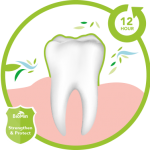Enamel, Demineralisation and Remineralisation
The BioMinF unique advantage
The BioMinF molecule is able to slowly release fluoride, calcium and phosphate ions over a period of 8 to 12 hours. Effectively reducing demineralisation and help to increase remineralisation of the tooth and fight decay.
Enamel, Demineralisation and Remineralisation
The outer layer of the tooth is known as the enamel, it is the hardest substance in the human body and because of this provides good resistance to abrasion and wear.
Enamel is essentially a hard wear resistant coating that protects the underlying softer dentine. Not only does enamel protect the underlying dentine mechanically it also protects the dentine against acid erosion arising from acids in carbonated drinks and fruit juices, as well as the acids produced by bacteria that cause decay (caries). Loss of enamel results in exposure of the dentine and leads to tooth decay and to dentine hypersensitivity.
The mineral hydroxyapatite makes up 98% of the tooth enamel. This mineral is in a continual state attack and repair, in a process called de-mineralisation and re-mineralisation.
Normally the saliva in the mouth has a PH of 7, not acidic or not basic or in simple terms in the middle or at equilibrium. The saliva is also supersaturated with regenerative calcium and phosphate ions. When sugars are consumed, bacteria in the mouth produce acids and becomes an unbalanced acidic environment. At around a “critical PH” of 5.5 the enamel (hydroxyapatite) begins to de-mineralise (dissolve) and the first steps towards tooth decay (caries) begins.
Fortunately, teeth can replace the lost minerals of “demineralisation” once
PH returns above the critical level of 5.5 if the saliva is super saturated with calcium and phosphate ions. The process called “remineralisation” (replacement of minerals and repair of the tooth) can occur.
In children, the “critical PH” is higher (ie. Closer to equilibrium / a less acidic environment) and makes them more susceptible to demineralisation and decay (caries). Also remineralisation in children is less effective. Effectively children are at greater risk of decay than adults.1
The benefits of fluoride:
For more than 30 years it has been known that fluoride helps control and retard tooth decay (caries). It has been added to drinking water and also found in most toothpastes. The fluoride penetrates the enamel and creates a fluorapatite protective layer of fluorapatite.
The fluorapatite is twice as strong as the tooth’s hydroxyapatite and has a lower critical PH of 4.5. This lower PH helps retard demineralisation and tooth decay from occurring. 2,3
When the saliva’s PH returns above 5.5 and is supersaturated with calcium and phosphate ions remineralisation can occur.3 This is further aided by fluoride which can speed up the remineralisation process by bring calcium and phosphate ions together.
Fluoride availability
For the formation of fluorapatite to occur fluoride must be present in the saliva above therapeutic levels. When washing teeth with traditional toothpastes, the fluoride levels rapidly decline with time. Over a period 15 min to 2 hours the fluoride concentration in mouth typically drop to 1– 3 ppm, and continue to decline to 0.5 to 0.02 ppm quite rapidly.4 Professor Ten Cate has stated “For treatments to be effective longer than the brushing and salivary clearance – fluoride needs to be deposited and slowly released5
The BioMinF molecule is able to slowly release fluoride, calcium and phosphate ions over a period of 8 to 12 hours to provide a solution that can help with tooth decay.
References
- 1. Anderson P, Hector MP, Rampersad MA, Critical pH in resting and simulated whole saliva in groups of children and adults, Int J Paediatr Dent, 2001, 11 (4):266-73.
- Featherstone JDB, Glena r, Shariati M, Shields CP, Dependence of invitro demineralization and remineralization of dental enamel on fluoride concentration, J Dent Res, 1990, 69:620-5.
- ten Cate JM, feathersone JDB, Mechaanistic aspects of the interactions between fluoride and dental enamel, Crit Rev Oral Biol 1991, 2:283-96.
- Rošin-Grget, K; Peroš, K; Sutej, I; Bašić, K (Nov 2013). “The cariostatic mechanisms of fluoride.”. Acta medica academica 42 (2): 179–88. doi:10.5644/ama2006-124 (2013)
- ten Cate JM: Current concepts on the theories of the mechanism of action of fluoride. Acta Odontol Scand 1999; 57: 325–329.
Related articles
Benefits of fluorapatite
Bioactive glasses dissolve under acidic conditions to protect teeth.
Fluorapatite is more resistant to acid than tooth enamel (hydroxyapatite) and hence gives greater protection against acid attack. Conventional toothpaste introduces fluoride during brushing, however, the fluoride rapidly diminishes at an exponential rate.
Fluorapatite is more resistant to acid than tooth enamel (hydroxyapatite) and hence gives greater protection against acid attack. Conventional toothpaste introduces fluoride during brushing, however, the fluoride rapidly diminishes at an exponential rate.

